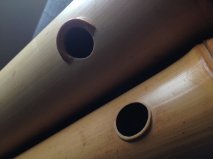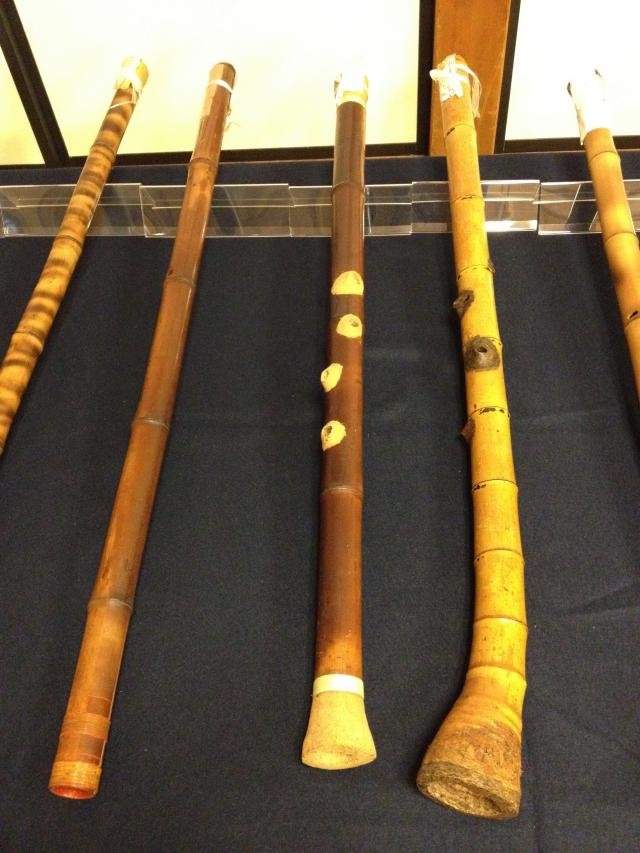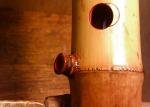Hole shaping?
Hole shaping?
Hi Folks,
I recently built up a hole on a large flute I'm making so I could cover the hole easier. I took the idea from my Shugetsu 2.7. See photo attached. My flute is on top of the photo and the Shugetsu is on the bottom. My question is; is there a precedent for this flutemaking technique of building up the holes of a Shakuhachi? Is there an established name/description for this detail? Any info on the subject would be great, thanks.

I recently built up a hole on a large flute I'm making so I could cover the hole easier. I took the idea from my Shugetsu 2.7. See photo attached. My flute is on top of the photo and the Shugetsu is on the bottom. My question is; is there a precedent for this flutemaking technique of building up the holes of a Shakuhachi? Is there an established name/description for this detail? Any info on the subject would be great, thanks.

There was a guy named Iwamizu Genpu, born in 1913, who made finger holes like that.
Below is some of the extreme ones. As far as I know there is no particular name for this technique.... but that can just be me not knowing.
Iwamizu's collection of extreme and amazing flutes can be seen in the Jinashi Museum led by Shimura Zenpo in Osaka.

Below is some of the extreme ones. As far as I know there is no particular name for this technique.... but that can just be me not knowing.
Iwamizu's collection of extreme and amazing flutes can be seen in the Jinashi Museum led by Shimura Zenpo in Osaka.

Does that mean that the actual size of the holes is not crucial to the sound or are we entering a very technical area of shakuhachi making?
Kiku, thanks for your reply. I recall seeing those flutes at WSF 2012. They definitely looked fantastic, unfortunately I didn't have a chance to HEAR them. My impression for this technique is that it's fairly modern, but I could be wrong. I wonder if flutemakers other than Shugetsu use this technique, and if it only applies to long flutes.
"felix martens""felix martens"Does that mean that the actual size of the holes is not crucial to the sound or are we entering a very technical area of shakuhachi making?
No, hole size and shape affects pitch and sound/timbre a lot.
"Ryuraku""Ryuraku"Hi Folks,
I recently built up a hole on a large flute I'm making so I could cover the hole easier. I took the idea from my Shugetsu 2.7... My question is; is there a precedent for this flutemaking technique of building up the holes of a Shakuhachi? Is there an established name/description for this detail? Any info on the subject would be great, thanks.
Hey Ryuraku, Your work looks great!
I first saw raised tone holes in 2002 when I started studying with Kinya in Saitama, Japan. He used two methods - bamboo dust built up with CA Glue and/or Ji plaster. Both were sealed and finished with urushi lacquer that matched the bamboo color. Then, I saw Shugetsu's work at the Big Apple Shakuhachi Festival in 2004 in New York City. It was similar to Kinya's finished work - refined and elegant. Sometime around then, I received a John Neptune 2.7 Chokan to work on that had a raised Tsu tone hole. I don't know who did the work but it was done with bamboo dust and glue. It wasn't finished with urushi but still polished and well-crafted. Recently, Jim had me do similar work on his 2.4. He said that John called them Geta (after the Japanese platform shoes). I had been doing these in Kinya's style but decided to do a Geta for Jim's flute since it was for the tiny Tsu meri hole. For the chimney, I used a small bamboo branch off the stalk.

"Lowblow""Lowblow"No, hole size and shape affects pitch and sound/timbre a lot.
Yes they do!
Cheers, Perry
Last edited by Perry Yung on 2013-08-19, 04:49; edited 1 time in total
funny i was wondering about the same thing very recently, in my opinion there are 2 reasons to make that "chimney".
1 - the longer the chimney the lower the pitch - which means, you can make a very big flute, and use this technique on some of the holes in order to make them higher in the bore and easier to reach. (i saw it done on a bansuri by a maker here in israel, he used an oval part of the bamboo wall as a platform on top of the flutes bamboo in order to make it thicker, and in that lower pitch, and the hole was positioned higher on the flute.
2 - half chimney like what you have done in the picture, i saw one of those on one of Pepe's flute's, a 3.0 and the only reason it is done is to allow an easier seal for the thumb hole on large flutes.
unfortunately i don't have any picture of either at the moment, but i hope my explanation was clear.
Itamar
1 - the longer the chimney the lower the pitch - which means, you can make a very big flute, and use this technique on some of the holes in order to make them higher in the bore and easier to reach. (i saw it done on a bansuri by a maker here in israel, he used an oval part of the bamboo wall as a platform on top of the flutes bamboo in order to make it thicker, and in that lower pitch, and the hole was positioned higher on the flute.
2 - half chimney like what you have done in the picture, i saw one of those on one of Pepe's flute's, a 3.0 and the only reason it is done is to allow an easier seal for the thumb hole on large flutes.
unfortunately i don't have any picture of either at the moment, but i hope my explanation was clear.
Itamar
"Perry Yung""Perry Yung"I received a John Neptune 2.7 Chokan to work on that had a raised Tsu tone hole. I don't know who did the work but it was done with bamboo dust and glue. It wasn't finished with urushi but still polished and well-crafted. Recently, Jim had me do similar work on his 2.4. He said that John called them Geta (after the Japanese platform shoes). I had been doing these in Kinya's style but decided to do a Geta for Jim's flute since it was for the tiny Tsu meri hole. For the chimney, I used a small bamboo branch off the stalk.
Brilliant solution, Perry.
Répondre
